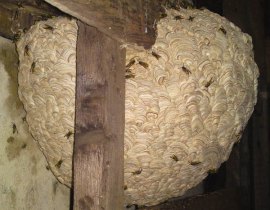Professional Pest Control & Wildlife Management
Wasp Nests
There are in fact many as 300 different wasp species here in the UK, however when you see a ‘wasp’ it is probably one of six common species. These species live in colonies and construct large nests from wood pulp often in our homes and gardens, each nest can contain upto 10,000 worker wasps, all of which have a nasty sting in their tails.
If you would like to make an appointment please contact us by telephone on 01284 799398 or through our enquiry form.
Queen wasps are large insects and are commonly found in the home in early april/may. They are looking for somewhere to build a nest and are often confused with masonary bees which also tend to buzz around holes and roof tiles. Hornets are infact just large wasps, generally living in smaller colonies they make up for this with their impressive size. There are also solitary wasps, which are rarely a problem and can be fascinating creatures to watch.
Wasps are in fact quite beneficial to our gardens, by hunting other insects they are natures own pest controllers. However they also possess a powerful venom in their sting and Wasps can be most aggressive when defending their nests.
-
Risks
The black and yellow colouration is warning to all that these insects carry a powerful sting which can cause a serious reaction in some humans. Reactions to wasps stings vary greatly, for some of us its comparable to stinging nettles, others suffer more with quite extreme localised swelling and in the worst cases Anaphylactic Shock.
Anaphylactic shock kills approximately 12-15 people each year here in the Uk. If you are sensitive to wasp stings and are stung, seek medical assistance immediately. If you are unsure as to how you may react to a sting it is advisable that you have nests destroyed professionally.
-
Treatment
Wasp nests are usually destroyed externally providing their access point can be located. Using a powerful contact dust pesticide the wasps take the active ingredient into the nest killing the queen, all workers and pupae. We guarantee full nest destruction within 24 hours of treatment (2-3 hours is the norm). If the entrance to the nest cannot be found externally we will enter the loft cavity and administer a residual pesticide spray directly into the nest, again with guaranteed results.
The removal of the nest is subject to access and is an additional service.
-
Life Cycle
In early April Queen wasps emerge from their hibernation and seek out suitable sites for their nests. Nest sites can be holes in the ground, compost heaps, lofts, hedges, tree’s, on the outside of buildings and just about everywhere else imaginable.
She begins by carefully crafting a small golf ball sized construction made from wood fibres and saliva. Within in this small nest she lays around a dozen eggs which hatch into larvae before pupating into young wasps. All of the young she produces from now until late summer will be sterile female workers. These drones work tirelessly on increasing the nest size and feeding the young larvae.
Towards the end of summer the queen begins to only lay eggs which will turn into new queens and males. This next generation of wasps will reproduce, the males dying off and the new queens seeking out a place to hibernate.
Once the new queens have fledged the nest the workers (typically around 5000 of them) concentrate on finding food for themselves. It is their desire for sugar which drives them into conflict with humans. Sweet wrappers, Ice cream, soft drinks etc prove just irresistible.
- False Widow Spider Removal
- Cluster Fly help
- The trouble with fleas?
- Mole Catching in Suffolk
- Rats in the Garden
- Wasp Nest Control
- Rats in your chicken Coop
- Anaphylaxis
- Bee Swarms
- Becoming a Beekeeper
- Rare Breed Poultry
- Pest Control with Birds of Prey
- Un-marked vehicles available
- Rabbiting with Ferrets
- Myxomatosis
- Poll-Tex Mesh
- Honorary Member Russell Wallis
- Free Rabbit Control


